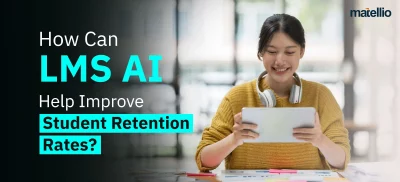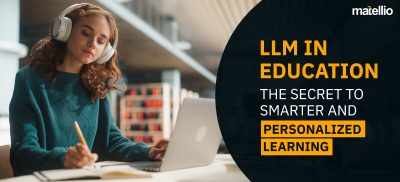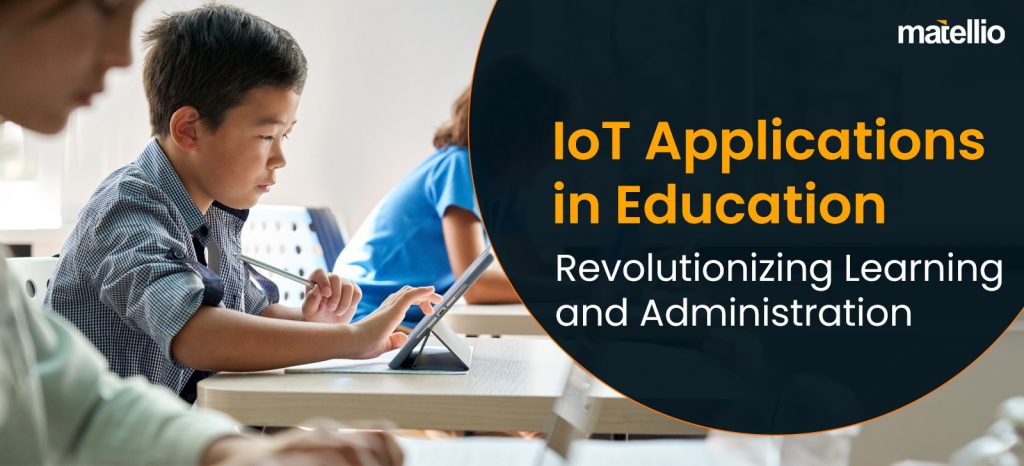
The education sector is rapidly evolving with the integration of connected technologies. From smart classrooms to automated campus management, IoT is enhancing efficiency, security, and engagement. With IoT applications in education, institutions can optimize resources, improve student safety, and create personalized learning experiences tailored to diverse needs.
Beyond academics, IoT empowers institutions with data-driven decision-making. Smart attendance systems, real-time performance tracking, and AI-powered analytics refine teaching methods and streamline administration. As educational businesses scale, IoT-driven solutions ensure long-term growth, efficiency, and adaptability to evolving learning demands.
IoT in Education – Market Stats
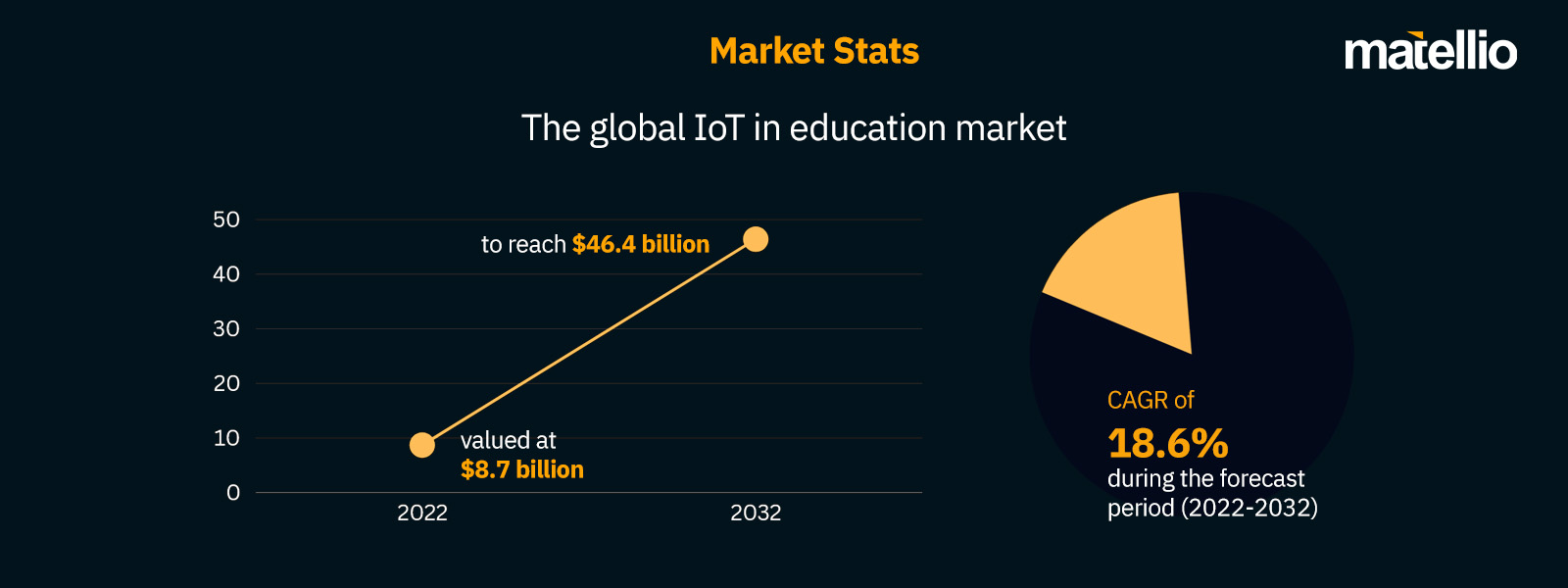 Source: Allied Market Research
Source: Allied Market Research
Why Should Businesses Invest in Applications of IoT in Education?
The Internet of Things in Education is transforming the way institutions manage resources, enhance student engagement, and optimize administrative efficiency. IoT-powered solutions enable real-time monitoring, automation, and data-driven insights that help schools, universities, and EdTech companies stay ahead in an increasingly digital world. By investing in IoT, businesses can foster innovation, improve security, and ensure scalable growth for institutions looking to modernize their learning environments.
Here’s why investing in IoT solutions for education is a game-changer:
 Smarter Learning Spaces
Smarter Learning Spaces
IoT-enabled smart classrooms use automated temperature control, smart lighting, and air quality monitoring to create an optimal learning environment. Sensors adjust classroom conditions based on real-time occupancy and external factors, ensuring that students remain comfortable and focused. By integrating automation, institutions enhance energy efficiency and significantly reduce operational costs, making IoT a sustainable investment for the education sector.
 Personalized Learning
Personalized Learning
The applications of IoT in education leverage AI-powered analytics to tailor learning experiences based on student performance and engagement levels. Smart devices track student interactions in classrooms, identify learning patterns, and provide personalized recommendations for teachers. With IoT-driven adaptive learning, institutions can cater to individual student needs, improving retention rates and overall academic outcomes.
 Advanced Security & Campus Monitoring
Advanced Security & Campus Monitoring
A connected campus ensures safety with real-time surveillance, biometric authentication, and RFID-based smart ID cards. The Internet of Things and Education work together to create secure environments where only authorized personnel and students can access specific areas. Smart security cameras, motion sensors, and real-time alerts help prevent security breaches and ensure a safer learning environment for students and faculty.
 Data-Driven Decision-Making
Data-Driven Decision-Making
IoT-powered solutions collect data on student attendance, classroom occupancy, and resource usage. AI-backed analytics transform this information into actionable insights, helping educators and administrators make informed decisions. IoT applications in education allow institutions to optimize faculty planning, course structures, and classroom scheduling based on real-time data, leading to better operational efficiency.
 Seamless Remote & Hybrid Learning
Seamless Remote & Hybrid Learning
Cloud-connected IoT devices enable seamless integration with Learning Management Systems (LMS), allowing students and teachers to access educational content from anywhere. The future of IoT in education ensures that remote learners receive the same level of engagement as in-person students through smart lecture recording, AI-powered chatbots, and real-time collaboration tools.
 Cost Optimization with Asset Management
Cost Optimization with Asset Management
IoT-driven asset tracking helps institutions manage and monitor educational resources like lab equipment, library books, and digital learning devices. By preventing resource misplacement and automating inventory tracking, schools and universities reduce costs and eliminate unnecessary purchases. Businesses partnering with an IoT development company can implement predictive maintenance, ensuring that equipment remains functional and reducing repair costs over time.
 Scalable Solutions
Scalable Solutions
Educational institutions require flexible and scalable infrastructure to support growing student populations and evolving digital trends. Investing in IoT solutions for education enables seamless expansion without operational disruptions. IoT-integrated platforms allow institutions to integrate new technologies effortlessly, ensuring a smooth transition into the future of digital education.
Key Components of IoT in Education Systems
The Internet of Things in Education is driving a technological revolution in classrooms, campuses, and online learning platforms. IoT-powered solutions are enhancing student engagement, streamlining administrative processes, and improving security across institutions. With real-time data collection, automation, and advanced analytics, IoT ensures that education becomes more accessible, efficient, and tailored to evolving needs.
Below are the key components that power IoT applications in education and contribute to their seamless functionality.
Smart Sensors & Devices
IoT-enabled smart sensors, RFID tags, and connected devices play a crucial role in IoT in education industry, automating attendance tracking, monitoring environmental conditions, and ensuring student safety. These devices help create optimized classroom environments, improving overall learning experiences and operational efficiency.
Cloud Infrastructure
The Internet of Things and Education work together to enable cloud-based storage and real-time data management. Cloud computing allows educational institutions to store student records, course materials, and administrative data securely while facilitating remote learning and multi-campus collaboration.
AI & Learning Analytics
AI-driven applications of IoT in education help analyze student performance, classroom engagement, and faculty efficiency. With machine learning algorithms processing real-time data, educators can personalize learning experiences, predict academic outcomes, and enhance overall educational strategies.
Smart Campus Automation
With IoT solutions for education, institutions can optimize campus facilities through automation. IoT-driven energy management systems regulate lighting, HVAC, and security controls, reducing operational costs while improving student comfort and campus safety. Biometric-based access control further strengthens security by restricting unauthorized entry.
Biometric & Wearable Tech
One of the key benefits of IoT in education is the integration of biometric systems and wearable technology to streamline attendance tracking, monitor student movement, and improve security. Smart ID cards and IoT wearables enhance both classroom participation tracking and remote identity verification, ensuring secure and efficient education management.
Automated Asset Tracking
The future of IoT in education includes smarter inventory management using RFID and barcode scanning. Schools and universities can leverage IoT-powered asset tracking to monitor the usage and location of books, lab equipment, and digital learning tools, reducing losses and optimizing resource allocation.
Models of IoT Transforming Businesses in the Education Sector
The Internet of Things in education is revolutionizing how learning institutions operate, enabling smarter classrooms, efficient resource management, and personalized learning experiences. Businesses investing in IoT can enhance operational efficiency, improve student engagement, and streamline administrative processes. Below are some key models shaping the future of education technology.
Smart Classroom & Interactive Learning Model
Smart classrooms integrate IoT-driven devices, AI-powered assistants, and applications of IoT in education to create dynamic learning environments. Smartboards, IoT-connected tablets, automated climate control, and voice-activated teaching assistants enhance the learning experience.
Impact on Businesses
- Enhances benefits of IoT in education by improving engagement and interactivity.
- Enables remote and hybrid learning models, making education more accessible.
- Automates classroom conditions to ensure a comfortable and optimized learning environment.
- Empowers edtech companies by integrating IoT-driven learning tools into existing platforms.
IoT-Powered Student Performance & Behavior Analytics
IoT sensors, wearables, and AI-powered analytics track student attendance, engagement, and performance, providing educators with real-time data. This IoT in education case study model is already being implemented by several institutions to optimize learning outcomes.
Impact on Businesses
- Provides why is IoT important in education insights by helping educators personalize learning.
- Helps corporate training programs and universities improve student retention.
- Enables adaptive curriculum development based on real-time student behavior.
- Supports e-learning platforms in delivering data-driven education models.
Connected Campus & Smart Infrastructure Management
IoT-based smart campuses use motion sensors, automated security systems, and smart energy management to optimize resources and enhance safety. Challenges of IoT in education such as security concerns and resource wastage are effectively addressed through automation and predictive analytics.
Impact on Businesses
- Reduces operational costs by automating campus security and energy management.
- Provides institutions with digital transformation services for a seamless transition into tech-driven operations.
- Strengthens campus security with real-time tracking and AI-driven surveillance.
- Optimizes facility management with smart lighting, HVAC automation, and digital visitor tracking.
AI-Driven Personalized Learning & Adaptive Education Model
AI-powered learning platforms use IoT applications in education to adapt course content based on student learning patterns. AI tutors and personalized lesson plans enhance engagement and ensure effective knowledge retention.
Impact on Businesses
- It offers a glimpse into the future of IoT in education by creating AI-driven learning pathways.
- Supports e-learning businesses in building adaptive education platforms.
- Automates student progress tracking, reducing the administrative workload.
- Enhances corporate training platforms by tailoring lessons based on employee learning speed.
IoT-Powered Smart Library & Resource Management
IoT-powered libraries implement RFID tracking, automated check-in/check-out kiosks, and AI-driven content management for better resource allocation. These features streamline library operations and improve accessibility.
Impact on Businesses
- Improves IoT in education market adoption by enhancing library automation.
- Helps universities and research institutions prevent book loss through real-time tracking.
- Reduces manual effort for librarians and administrative staff.
- Supports digital content providers in distributing resources efficiently.
Remote Examination & Smart Proctoring Model
AI-driven proctoring software powered by IoT devices uses biometric authentication, facial recognition, and motion detection to ensure secure online examinations. How is IoT used in education to prevent exam fraud? AI-driven behavioral tracking makes online assessments foolproof.
Impact on Businesses
- Ensures secure remote exams for online education platforms.
- Reduces manual effort in proctoring and grading, improving efficiency.
- Enhances credibility of distance learning programs by minimizing fraud.
- Supports businesses in automating certification and assessment processes.
Predictive Maintenance & Asset Management
IoT sensors monitor IT infrastructure, laboratory equipment, and classroom devices to predict maintenance requirements before failures occur. Challenges of IoT in education like unexpected breakdowns and infrastructure inefficiencies are minimized with predictive analytics.
Impact on Businesses
- Reduces maintenance costs and enhances operational continuity.
- Helps facility management companies optimize asset utilization.
- Supports IoT solutions for education by ensuring seamless tech-driven learning environments.
- Prevents disruptions in digital education by maintaining reliable IoT-powered infrastructure.
Begin Your Journey to a Smarter, Connected Learning Environment Today.
Top IoT Applications in Education
1. Smart Classrooms
Smart classrooms utilize IoT applications in education to create an interactive and engaging learning environment. Features such as smart boards, connected projectors, and IoT-enabled learning tools enhance the teaching and learning process.
2. Connected Campuses
Connected campuses leverage IoT applications in education to link various systems and devices, facilitating seamless communication and data sharing. This integration supports efficient campus management and enhances the overall student experience.
3. Personalized Learning
IoT applications in education enable personalized learning by collecting and analyzing data on student performance and preferences. This data-driven approach allows educators to tailor lessons to individual needs, improving learning outcomes.
4. Smart Administration
IoT applications in education simplify administrative tasks by automating processes such as attendance tracking, asset management, and resource allocation. This automation frees up time for educators to focus on teaching and student support.
5. Enhanced Security and Safety
IoT applications in education enhance campus security through connected surveillance systems, smart locks, and real-time alerts. These technologies ensure a safe learning environment for students and staff.
6. Interactive Whiteboards
IoT-enabled interactive whiteboards allow for dynamic and collaborative learning sessions. Teachers can display digital content, annotate in real-time, and engage students with interactive activities.
7. Smart Lighting and HVAC Systems
IoT applications in education systems can control lighting and HVAC (heating, ventilation, and air conditioning) to create a comfortable and energy-efficient learning environment. Automated adjustments based on occupancy and environmental conditions help reduce energy costs.
8. Wearable Devices
Wearable devices such as smartwatches and fitness trackers can monitor student health and wellness. These devices can track physical activity, sleep patterns, and even stress levels, providing valuable data to improve student well-being.
9. Real-Time Language Translation
IoT-powered language translation devices can facilitate communication in multilingual classrooms. These devices can translate spoken language in real-time, helping students and teachers overcome language barriers.
10. Smart ID Cards
IoT-enabled smart ID cards can be used for access control, attendance tracking, and cashless transactions within the campus. These cards enhance security and streamline administrative processes.
11. Intelligent Tutoring Systems
IoT-based intelligent tutoring systems use data analytics and machine learning to provide personalized feedback and guidance to students. These systems can adapt to individual learning styles and pace, improving student outcomes.
12. Smart Lab Equipment
IoT-enabled lab equipment allows for remote monitoring and control of experiments. Students can conduct experiments and collect data in real-time, even from remote locations, enhancing their hands-on learning experience.
13. Automated Attendance Systems
IoT-based attendance systems use biometric or RFID (radio-frequency identification) technology to automatically record student attendance. This reduces administrative workload and ensures accurate attendance records.
14. Smart Library Systems
IoT applications in education include smart library systems that use RFID tags to track books and resources. These systems facilitate efficient inventory management and enhance the user experience with automated check-in and check-out processes.
15. Classroom Analytics
IoT devices can collect data on classroom activities, such as student participation and engagement levels. This data can be analyzed to identify trends and improve teaching strategies.
16. Smart Desks
IoT-enabled smart desks can adjust height, monitor posture, and provide interactive learning tools. These desks create a more ergonomic and engaging learning environment.
17. Environmental Monitoring
IoT sensors can monitor environmental conditions such as air quality, temperature, and humidity within educational facilities. Maintaining optimal conditions ensures a healthy and conducive learning environment.
18. Remote Learning Solutions
IoT applications in education support remote learning by providing connected devices and platforms for virtual classrooms. Students and teachers can interact and collaborate in real-time, regardless of their physical location.
19. Gamified Learning Platforms
IoT-enabled gamified learning platforms use sensors and interactive tools to create engaging and motivating learning experiences. These platforms leverage game mechanics to enhance student participation and retention.
Lead Your Institution with State-of-the-Art IoT Applications in Education.
Case Study: IFAS Online Education Portal
Introduction to the IFAS Project
The IFAS project, a comprehensive online education portal developed by Matellio, showcases the practical application of IoT in education. The portal offers a wide range of features, including real-time data tracking and personalized learning paths.
Implementation Details
The implementation involved integrating various IoT devices and systems to create a seamless and efficient online learning environment. This integration enabled real-time data collection and analysis, supporting personalized learning experiences.
Benefits Achieved
The IFAS portal improved student engagement, enhanced learning outcomes, and streamlined administrative processes. The success of the project highlights the potential of IoT applications in education.
Challenges Solved Using IoT in Education
The Internet of Things in education is driving a significant transformation, solving some of the most persistent challenges institutions face. By integrating IoT-driven automation and real-time data analytics, educational institutions can create a smarter, more efficient, and connected ecosystem.
Here’s how IoT applications in education are solving major challenges:
Inefficient Resource Tracking
Challenge:
Managing books, lab equipment, and digital devices across multiple classrooms or campuses becomes complex without proper tracking systems. Institutions often deal with misplaced resources, excessive replacement costs, and inefficient asset management.
Solution:
IoT-powered smart tracking solutions, such as RFID tags and IoT-enabled inventory systems, allow institutions to monitor asset movement and usage in real-time. By implementing IoT solutions for education, administrators can significantly reduce resource wastage, automate inventory management, and improve overall operational efficiency.
Campus Security Gaps
Challenge:
Ensuring student and faculty safety is a growing concern. Unauthorized access, security breaches, and inefficient monitoring make campuses vulnerable to threats.
Solution:
Biometric authentication, RFID-based smart ID cards, and AI-integrated surveillance cameras enhance campus security. With the Internet of Things and education, institutions can enable real-time access control, automatic security alerts, and instant threat detection, ensuring a safer environment for students and staff.
Low Student Engagement
Challenge:
Traditional teaching methods fail to engage students effectively, resulting in lower participation, reduced retention, and limited academic performance.
Solution:
IoT-driven smart classrooms, equipped with interactive learning tools, AI-based progress tracking, and real-time feedback systems, personalized education. Adaptive learning models, enabled by why is IoT important in education, provide customized lesson plans, ensuring improved engagement and knowledge retention.
Lack of Real-Time Insights
Challenge:
Institutions often struggle with decision-making due to a lack of access to real-time data on student performance, faculty workload, and resource allocation.
Solution:
IoT-powered data analytics platforms collect and analyze real-time student engagement, classroom occupancy, and faculty utilization data. This allows institutions to make data-driven decisions and improve overall academic outcomes. Schools looking to enhance strategic planning can submit RFP to get tailored IoT solutions that align with their institution’s unique challenges.
High Energy Consumption
Challenge:
Unregulated use of lighting, air conditioning, and other utilities leads to excessive energy consumption, increasing operational costs for educational institutions.
Solution:
IoT-enabled energy management systems use smart sensors to detect room occupancy, automatically adjusting lighting and climate controls. Schools and universities utilizing the Internet of Things in education reduce energy wastage and cut down operational expenses while promoting sustainability.
Manual Attendance & Student Tracking
Challenge:
Taking attendance manually is inefficient and prone to errors. Additionally, monitoring students across large campuses remains a challenge.
Solution:
IoT-powered attendance systems use biometric verification, RFID-based tracking, and real-time location monitoring to streamline attendance records. Challenges of IoT in education are addressed with automated, error-free tracking, reducing administrative workload and improving student accountability.
Outdated Administrative Systems
Challenge:
Paper-based record-keeping and manual scheduling lead to inefficiencies in admissions, fee collection, and academic planning.
Solution:
IoT-integrated administration platforms automate student record management, exam scheduling, and fee transactions. Institutions investing in IoT applications in education can streamline administrative workflows, reduce paperwork, and enhance overall efficiency.
Read More: Explore transformative IoT use cases in education to enhance learning experiences and drive innovation in the digital classroom.
Enhance Your Educational Efficiency and Engagement with Our Expert IoT Services.
Future Trends Driving IoT Applications in Education
The Internet of Things in education is revolutionizing how institutions manage resources, personalize learning, and improve security. As technology advances, IoT enables data-driven decision-making, streamlines operations, and enhances student engagement. Schools, universities, and EdTech firms are leveraging IoT applications in education to create smarter and more responsive learning ecosystems.
 AI-Powered Smart Classrooms
AI-Powered Smart Classrooms
Educational institutions are integrating AI with IoT solutions for education to create dynamic smart classrooms. AI analyzes student engagement, classroom interactions, and performance data to provide real-time insights. These systems allow educators to adjust teaching methods instantly, ensuring a personalized and adaptive learning experience. The combination of AI and IoT enhances lesson planning, optimizes resource allocation, and improves student comprehension rates.
 Predictive Maintenance
Predictive Maintenance
IoT sensors in school infrastructure help monitor equipment, track building conditions, and predict maintenance needs before failures occur. Schools adopting IoT consulting services can proactively manage HVAC systems, lighting, and security systems, reducing energy consumption and minimizing downtime. Predictive maintenance ensures a safer learning environment while lowering operational costs and extending the lifespan of institutional assets.
 Automated Student Tracking
Automated Student Tracking
IoT-powered attendance systems, RFID tags, and biometric recognition streamline student tracking, reducing administrative workload and improving accuracy. Schools utilizing the Internet of Things and education can automate attendance records, monitor real-time student movements, and track classroom engagement. These systems provide valuable insights into student participation, helping educators implement personalized intervention strategies for at-risk students.
 Wearable Tech for Learning
Wearable Tech for Learning
Wearable devices like smartwatches and AR headsets are transforming the way students learn and interact. Institutions investing in IoT integration services use these technologies to enhance interactive learning experiences, monitor student well-being, and track engagement levels. Wearables facilitate real-time feedback, improve collaboration, and ensure a more immersive and personalized education experience.
 Energy-Efficient Campuses
Energy-Efficient Campuses
Schools and universities are turning to IoT for sustainable energy management. Smart sensors connected to IoT applications in education automatically adjust lighting, heating, and cooling based on classroom occupancy, reducing unnecessary energy consumption. These systems help institutions lower carbon footprints, decrease energy bills, and promote eco-friendly learning environments.
 Adaptive Learning Systems
Adaptive Learning Systems
IoT-powered adaptive learning platforms track student interactions, monitor comprehension levels, and tailor coursework based on performance data. Schools leveraging IoT solutions for education use these platforms to modify lesson plans in real-time, ensuring that each student receives content suited to their learning pace and needs. This data-driven approach improves engagement, retention, and academic performance.
 Real-Time Data Insights
Real-Time Data Insights
Educational institutions are increasingly relying on IoT-driven analytics to optimize faculty efficiency, monitor student progress, and improve resource allocation. Schools adopting the future of IoT in education use real-time data to enhance decision-making, identify areas for improvement, and refine institutional strategies. Predictive analytics help universities enhance course planning, improve student outcomes, and streamline administrative operations.
Predictions for the Future
Increased Adoption of Smart Technologies
- Prediction: More educational institutions will integrate IoT in education to create smart campuses.
- Impact: This will lead to more efficient operations, enhanced learning experiences, and improved safety and security.
Greater Emphasis on Personalized Learning
- Prediction: Personalized learning will become the norm, driven by data collected from IoT devices.
- Impact: Students will benefit from customized educational experiences that cater to their individual needs and learning styles.
Expansion of Remote and Hybrid Learning Models
- Prediction: IoT applications in education will support the growth of remote and hybrid learning models, making education more accessible.
- Impact: Students will have greater flexibility in how they learn, and educators will be able to reach a broader audience.
Enhanced Collaboration and Engagement
- Prediction: IoT-enabled tools will facilitate greater collaboration and engagement among students and teachers.
- Impact: Interactive and collaborative learning environments will foster better communication and teamwork skills.
How Educational Institutions Can Prepare
Invest in IoT Infrastructure
- Action: Allocate resources to build a robust IoT infrastructure that supports various applications in education.
- Benefit: Ensures seamless integration of IoT technologies, leading to enhanced learning experiences and operational efficiencies.
Foster a Culture of Innovation
- Action: Encourage educators and administrators to embrace innovative technologies and methodologies.
- Benefit: Creates a dynamic learning environment that adapts to technological advancements and student needs.
Stay Updated with Technological Advancements
- Action: Keep abreast of the latest developments in IoT and related technologies.
- Benefit: Allows institutions to implement cutting-edge solutions that improve educational outcomes.
Collaborate with Technology Partners
- Action: Partner with experienced IoT consulting services and technology consulting services.
- Benefit: Leverages external expertise to ensure successful implementation and maintenance of IoT applications in education.
Provide Training and Support
- Action: Offer comprehensive training programs for educators and staff on using IoT applications in education.
- Benefit: Ensures that all stakeholders are proficient in utilizing IoT tools, leading to more effective teaching and administration.
Prioritize Data Security and Privacy
- Action: Implement robust data security measures to protect sensitive information collected through IoT devices.
- Benefit: Safeguards student and institutional data, maintaining trust and compliance with regulations.
How Can Matellio Help with IoT Applications in Education?
The integration of IoT applications and cloud computing in education system offers immense potential for transforming the learning experience. By leveraging IoT applications in education, educational institutions can create more interactive, personalized, and efficient learning environments.
At Matellio, we specialize in delivering custom IoT solutions that enhance learning experiences, streamline operations, and improve student engagement.
Our Approach
- With deep expertise in IoT-driven education solutions, Matellio designs tailored applications to support schools, universities, and EdTech providers.
- Whether you aim to implement smart classrooms, IoT-powered attendance tracking, virtual labs, or student performance analytics, our team ensures that your IoT initiatives are scalable, secure, and future-ready.
- By leveraging our technology consulting services, Matellio ensures that IoT solutions in education are aligned with your institution’s goals, enhancing learning accessibility, engagement, and administration.
- We work closely with educational institutions to identify key areas for IoT adoption, including personalized learning, remote education, smart campus automation, and energy-efficient infrastructure.
- Our solutions seamlessly integrate with existing learning management systems (LMS), cloud-based platforms, and digital education tools, ensuring a smooth transition to IoT-powered learning.
- With a focus on automation, data security, and real-time insights, our IoT implementations help educators deliver personalized education while optimizing operational efficiency.
If you’re looking for insights into IoT applications in education, implementation strategies, or guidance on integrating IoT with your digital learning infrastructure, our team is ready to assist you. Fill out the form to schedule an expert consultation.
Frequently Asked Questions (FAQs)
Q1. How do you protect IoT data in education?
We ensure data security in IoT-powered education systems with advanced encryption, secure access control, and real-time monitoring. Our solutions comply with industry standards to protect student and institutional data from unauthorized access.
Q2. Can IoT solutions integrate with our existing education infrastructure?
Yes. Our IoT solutions are designed to integrate seamlessly with your current LMS, cloud-based platforms, and on-campus systems. We ensure smooth connectivity between IoT devices, learning tools, and administrative platforms for a unified experience.
Q3. How long does it take to implement IoT solutions in education?
The implementation timeline depends on the scope of the project, number of IoT devices, and required integrations. After assessing your institution’s needs, we provide a structured deployment plan for a smooth and efficient rollout.
Q4. What kind of post-deployment support do you provide?
We offer continuous post-deployment support, including system monitoring, troubleshooting, software updates, and performance optimization. Our team ensures your IoT solutions remain efficient, secure, and up to date.
Q5. What factors influence the cost of IoT implementation in education?
The cost of IoT deployment depends on factors such as the size of the institution, number of connected devices, and required features. We provide transparent pricing and tailor our solutions to fit your budget while maximizing long-term benefits.
 Smarter Learning Spaces
Smarter Learning Spaces Personalized Learning
Personalized Learning Advanced Security & Campus Monitoring
Advanced Security & Campus Monitoring Data-Driven Decision-Making
Data-Driven Decision-Making Seamless Remote & Hybrid Learning
Seamless Remote & Hybrid Learning Cost Optimization with Asset Management
Cost Optimization with Asset Management Scalable Solutions
Scalable Solutions
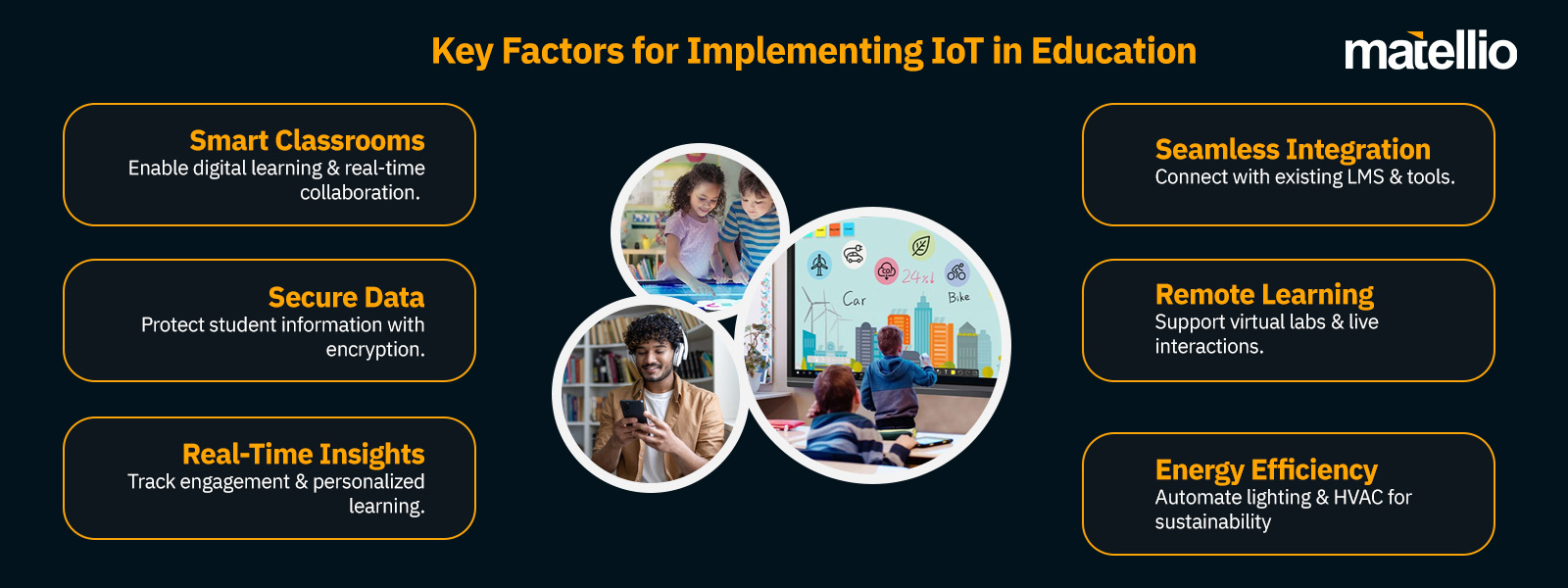
 AI-Powered Smart Classrooms
AI-Powered Smart Classrooms Predictive Maintenance
Predictive Maintenance Wearable Tech for Learning
Wearable Tech for Learning Energy-Efficient Campuses
Energy-Efficient Campuses Adaptive Learning Systems
Adaptive Learning Systems Real-Time Data Insights
Real-Time Data Insights